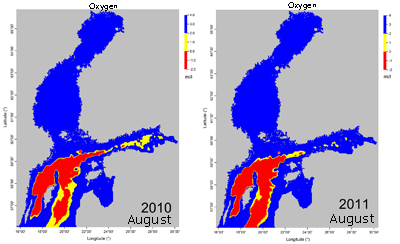Press release 2011-09-05 at 12:00
Aranda and Muikku, the research vessels of the Finnish Environment Institute, have returned from their August expeditions. On these tours, they studied the eutrophication of the Gulf of Finland, the southern Archipelago Sea, the Bothnian Bay and the Baltic Proper, the oxygen situation on the sea floor and changes in zoobenthic animal communities. Aranda monitored benthic animal communities on its tour of the Baltic Proper. These journeys form part of the long-term research undertaken by the Marine Research Centre of the Finnish Environment Institute into changes in the condition of the Baltic Sea. They also contribute to the joint HELCOM monitoring being conducted by the Baltic Sea countries.
The Baltic Sea’s oxygen depletion area is as extensive as it was in summer 2010, with poor conditions still found on deep Baltic Sea floors and in certain coastal water areas. The number of benthic animals is high on sea floors with oxygen, particularly in the southern Archipelago Sea but also in coastal waters in the Gulf of Finland. Even though no significant changes were seen in the amount of algae, the eutrophication of the Gulf of Finland seems to have levelled off over the previous decade, most significantly in the eastern parts. The oxygen situation in the Bothnian Sea and Bothnian Bay remains healthy.
Oxygen situation mainly poor and no benthic animals in the Baltic Proper
In recent years, the oxygen situation in the Baltic Sea's main basin has been extremely poor in central and northern deep water areas in the Baltic Proper (the deep water areas indicated in red on the picture showed high quantities of hydrogen sulphide, which forms on sea floors with no oxygen). Benthic fauna was completely absent from oxygen-depleted areas.
No significant changes in the condition of the Gulf of Finland compared to last year
The condition of the Gulf of Finland's coastal waters has improved since 2006 in outer archipelago areas, but oxygen depletion is still found in the eastern and western reaches of the inner archipelago. Conditions in these areas has not improved. In deep water areas of the Gulf of Finland, poorer oxygen conditions and higher nutrient concentrations are significantly influenced by the intermittent inflow of low-oxygen deep water from the Baltic Sea's main basin into the Gulf of Finland. In shallow and highly eutrophic coastal waters, summertime temperature stratification prevents oxygen from accessing the sea floor, reinforcing internal load which accelerates eutrophication.
At R/S Muikku’s observations sites, conditions in the bottom sediments and zoobenthic communities were similar to last year. However, only a quarter of all observed sites were completely without benthic animals. This result is the third best for the monitoring period beginning in 2001. However, most zoobenthic communities in the Gulf of Finland still comprise only a few species. In addition, their numbers are scarce in comparison to the souther reaches of the Archipelago Sea, for example. An alien species, the Marenzelleria viridis, was observed in abundant numbers in the Gulf of Finland's shallow sea floors, where the oxygen situation is reasonable; in places, Monoporeia affinis communities, indicating good sea floor conditions, had grown larger. However, on the deepest sea floors, the oxygen situation was poor, with a very low number of benthic animals seen at these R/S Aranda observation sites.
In the eastern reaches of the coastal waters of the Gulf of Finland, algae amounts were higher than last year, but in the inner archipelago of the Gulf’s western reaches, they were lower than last summer. At R/S Aranda’s observation sites in open sea areas in the Gulf of Finland and in the northern reaches of the Baltic Proper, the amount of algae was slightly lower than last year. Despite higher levels of algae seen in the eastern reaches of the Gulf of Finland and the outer archipelago than last summer, the summertime eutrophication levels in this area were markedly lower than they were in the middle of last decade. Eutrophication of the outer archipelago of the Gulf of Finland appears to have levelled off over the last ten years, most notably in the east.
Abundant oxygen on Bothnian Sea and Bothnian Bay sea floors
Since late 2010, saltier seawater has streamed in from the main basin of the Baltic Sea to the Bothnian Bay, via the Åland Sea and Archipelago Sea. Oxygen levels in the Bothnian Sea and the Bothnian Bay remain healthy, with even some improvement seen from last year.
The amount of algae in this area continues to be significantly lower than in the rest of the Baltic Sea. However, measured levels were higher than the previous year’s levels in some parts. Blue-green algae was seen in abundant numbers in plant plankton in the Bothnian Sea’s open sea areas, while green algae was seen in the Bothnian Bay.
|
Oxygen levels in the Baltic Sea in August 2010 and 2011. SYKE
|


|
|
|
More information:
Aranda:
Gulf of Finland:
Maiju Lehtiniemi, leader of the expedition, Finnish Environment Institute, tel. +358 40 7255 085, firstname.lastname@ymparisto.fi
Gulf of Bothnia and Baltic Sea Proper:
Pekka Kotilainen, leader of the expedition, Finnish Environment Institute, tel. +358 400 1485 20, firstname.lastname@ymparisto.fi
Alf Norkko (benthic animals), Marine Research Centre of the Finnish Environment Institute,
tel. +358 50 568 6766
Muikku:
Seppo Knuuttila, leader of the expedition, Finnish Environment Institute, tel. +358 40 7609 232, firstname.lastname@ymparisto.fi
Aira Saloniemi, SYKE Communications, Baltic Sea, tel. +358 400 1488 75, firstname.lastname@ymparisto.fi